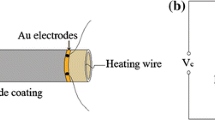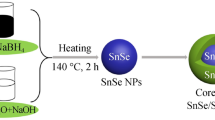Abstract
To detect low concentrations of formaldehyde selectively, the sensing properties of SnO2 nanostructured are enhanced by modifying with p-type semiconductor NiO. In this study, a nanostructured SnO2/NiO composite was prepared by a simple hydrothermal method. The X-ray photoelectron spectroscopy (XPS) peak in 532.4 eV proved that the existence of the SnO2/NiO composite structure increased the amount of adsorbed oxygen O− and O2− significantly. Gas-sensing tests showed that these mixed phases SnO2/NiO are highly promising for gas sensor applications, as the gas response for formaldehyde was significantly enhanced in gas response, selectivity at an operating temperature of 230 °C. The sensor fabricated by SnO2/NiO composite can detect as low as 1 ppm of formaldehyde at 230 °C, and the corresponding response is 1.57. The results of physicochemical properties tests of the samples show that the enhancement in sensitivity and selectivity is attributed to the oxygen vacancies and heterojunction between SnO2 and NiO. The SnO2/NiO composites can be applied to sensitive materials of formaldehyde sensors.










Similar content being viewed by others
References
R.-z. Liu, Q. Bao fu, L. Feng min, C. Li hua, and L. Min: Research on In2O3-based formaldehyde sensor. Electron. Compon. Mater. 25, 15 (2006).
N. Li, Y. Fan, Y. Shi, Q. Xiang, X. Wang, and J. Xu: A low temperature formaldehyde gas sensor based on hierarchical SnO/SnO2 nano-flowers assembled from ultrathin nanosheets: Synthesis, sensing performance and mechanism. Sens. Actuators, B 294, 106 (2019).
H. Zhu, J. She, M. Zhou, and X. Fan: Rapid and sensitive detection of formaldehyde using portable 2-dimensional gas chromatography equipped with photoionization detectors. Sens. Actuators, B 283, 182 (2019).
Z. Lin, N. Li, Z. Chen, and P. Fu: The effect of Ni doping concentration on the gas sensing properties of Ni doped SnO2. Sens. Actuators, B 239, 501 (2017).
L. Zhu and W. Zeng: Room-temperature gas sensing of ZnO-based gas sensor: A review. Sens. Actuators, A 267, 242 (2017).
R. Chava, S.-Y. Oh, and Y.-T. Yu: Enhanced H2 gas sensing properties of Au@In2O3 core-shell hybrid metal-semiconductor heteronanostructures. CrystEngComm 18, 3655 (2016).
S. Wang, W. Yu, C. Cheng, T. Zhang, and M. Ge: Fabrication of mesoporous SnO2 nanocubes with superior ethanol gas sensing property. Mater. Res. Bull. 89, 267 (2017).
S. Vallejos, T. Stoycheva, P. Umek, C. Navio, and R. Snyders: Au nanoparticle-functionalised WO3 nanoneedles and their application in high sensitivity gas sensor devices. Chem. Commun. 47, 565 (2011).
Z. Dou, C. Cao, Y. Chen, and W. Song: Fabrication of porous Co3O4 nanowires with high CO sensing performance at a low operating temperature. Chem. Commun. 50, 14889 (2014).
J.A. Dirksen, K. Duval, and T.A. Ring: NiO thin-film formaldehyde gas sensor. Sens. Actuators, B 80, 106 (2001).
C. Wang, X. Cheng, X. Zhou, P. Sun, X. Hu, K. Shimanoe, G. Lu, and N. Yamazoe: Hierarchical alpha-Fe2O3/NiO composites with a hollow structure for a gas sensor. ACS Appl. Mater. Interfaces 6, 12031 (2014).
Y.J. Jeong and C. Balamurugan: Enhanced CO2 gas-sensing performance of ZnO nanopowder by La loaded during simple hydrothermal method. Sens. Actuators, B 229, 288 (2016).
Y. Kaneti, Z. Zhang, C. Chen, and J. Yue: Solvothermal synthesis of ZnO-decorated alpha-Fe2O3 nanorods with highly enhanced gas-sensing performance toward n-butanol. J. Mater. Chem. A 2, 13283 (2014).
Y. Jeong, W.-T. Koo, J.-S. Jang, D.-H. Kim, and M.-H. Kim: Nanoscale PtO2 catalysts-loaded SnO2 multichannel nanofibers toward highly sensitive acetone sensor. ACS Appl. Mater. Interfaces 10, 2016 (2018).
M. Weber, J.-H. Lee, J.-Y. Kim, and I. Iatsunskyi: High-performance nanowire hydrogen sensors by exploiting the synergistic effect of Pd nanoparticles and metal-organic framework membranes. ACS Appl. Mater. Interfaces 10, 34765 (2018).
H. Chen, Y. Zhao, L. Shi, G.-D. Li, and L. Sun: Revealing the relationship between energy level and gas sensing performance in heteroatom-doped semiconducting nanostructures. ACS Appl. Mater. Interfaces 10, 29795 (2018).
H.-M. Jeong, J.-H. Kim, S.-Y. Jeong, C.-H. Kwak, and J.-H. Lee: Co3O4-SnO2 hollow heteronanostructures: Facile control of gas selectivity by compositional tuning of sensing materials via galvanic replacement. ACS Appl. Mater. Interfaces 8, 7877 (2016).
H. Ji, W. Zeng, and Y. Li: Gas sensing mechanisms of metal oxide semiconductors: A focus review. Nanoscale 11, 22664 (2019).
Z. Zhang, M. Xu, L. Liu, X. Ruan, and J. Yan: Novel SnO2@ZnO hierarchical nanostructures for highly sensitive and selective NO2 gas sensing. Sens. Actuators, B 257, 714 (2018).
S. Sen, P. Kanitkar, A. Sharma, K.P. Muthe, and A. Rath: Growth of SnO2/W18O49 nanowire hierarchical heterostructure and their application as chemical sensor. Sens. Actuators, B 147, 453 (2010).
F. Li, T. Zhang, X. Gao, R. Wang, and B. Li: Coaxial electrospinning heterojunction SnO2/Au-doped In2O3 core-shell nanofibers for acetone gas sensor. Sens. Actuators, B 252, 822 (2017).
L. Wang, H. Liu, H. Fu, Y. Wang, and K. Yu: Polymer g-C3N4 wrapping bundle-like ZnO nanorod heterostructures with enhanced gas sensing properties. J. Mater. Res. 33, 1401 (2018).
D. Wang, K. Wan, M. Zhang, H. Li, P. Wang, X. Wang, and J. Yang: Constructing hierarchical SnO2 nanofiber/nanosheets for efficient formaldehyde detection. Sens. Actuators, B 283, 714 (2019).
J. Walker, S. Akbar, and P. Morris: Synergistic effects in gas sensing semiconducting oxide nano-heterostructures: A review. Sens. Actuators, B 286, 624 (2019).
J. Hu, X. Li, X. Wang, Y. Li, and Q. Li: Hierarchical aloe-like SnO2 nanoflowers and their gas sensing properties. J. Mater. Res. 33, 1433 (2018).
Y. Cui, M. Zhang, X. Li, B. Wang, and R. Wang: Investigation on synthesis and excellent gas-sensing properties of hierarchical Au-loaded SnO2 nanoflowers. J. Mater. Res. 34, 2944 (2019).
A. Bhattacharya, Y. Jiang, Q. Gao, X. Chu, and Y. Dong: Highly responsive and selective formaldehyde sensor based on La3+-doped barium stannate microtubes prepared by electrospinning. J. Mater. Res. 34, 2067 (2019).
M. Di Giulio, G. Micocci, A. Serra, A. Tepore, R. Rella, and P. Siciliano: SNO2 thin-films for gas sensor prepared by rf reactive sputtering. Sens. Actuators, B 25, 465 (1995).
S. Bai, H. Fu, Y. Zhao, K. Tian, and R. Luo: On the construction of hollow nanofibers of ZnO-SnO2 heterojunctions to enhance the NO2 sensing properties. Sens. Actuators, B 266, 692 (2018).
K.S. Kim and N. Winograd: X-ray photoelectron spectroscopic studies of nickel-oxygen surfaces using oxygen and argon ion-bombardment. Surf. Sci. 43, 625 (1974).
H. Wang, Y. Qu, H. Chen, Z. Lin, and K. Dai: Highly selective n-butanol gas sensor based on mesoporous SnO2 prepared with hydrothermal treatment. Sens. Actuators, B 201, 153 (2014).
H. Ren, W. Zhao, L. Wang, S.O. Ryu, and C. Gu: Preparation of porous flower-like SnO2 micro/nano structures and their enhanced gas sensing property. J. Alloys Compd. 653, 611 (2015).
Y. Shimizu and M. Egashira: Basic aspects and challenges of semiconductor gas sensors. MRS Bull. 24, 18 (1999).
D. Hu, B. Han, S. Deng, Z. Feng, and Y. Wang: Novel mixed phase SnO2 nanorods assembled with SnO2 nanocrystals for enhancing gas-sensing performance toward isopropanol gas. J. Phys. Chem. C 118, 9832 (2014).
G. Yin, J. Sun, F. Zhang, W. Yu, and F. Peng: Enhanced gas selectivity induced by surface active oxygen in SnO/SnO2 heterojunction structures at different temperatures. RSC Adv. 9, 1903 (2019).
N. Yamazoe: New approaches for improving semiconductor gas sensors. Sens. Actuators, B 5, 7 (1991).
J. Sun, G. Yin, T. Cai, W. Yu, F. Peng, Y. Sun, F. Zhang, J. Lu, M. Ge, and D. He: The role of oxygen vacancies in the sensing properties of Ni substituted SnO2 microspheres. RSC Adv. 8, 33080 (2018).
W. Dai, X. Pan, S. Chen, C. Chen, and Z. Wen: Honeycomb-like NiO/ZnO heterostructured nanorods: Photochemical synthesis, characterization, and enhanced UV detection performance. J. Mater. Chem. C 2, 4606 (2014).
G. Sun, H. Chen, Y. Li, Z. Chen, S. Zhang, G. Ma, T. Jia, J. Cao, H. Bala, X. Wang, and Z. Zhang: Synthesis and improved gas sensing properties of NiO-decorated SnO2 microflowers assembled with porous nanorods. Sens. Actuators, B 233, 180 (2016).
H.-J. Kim and J.-H. Lee: Highly sensitive and selective gas sensors using p-type oxide semiconductors: Overview. Sens. Actuators, B 192, 607 (2014).
C. Liu, L. Zhao, B. Wang, P. Sun, Q. Wang, Y. Gao, X. Liang, T. Zhang, and G. Lu: Acetone gas sensor based on NiO/ZnO hollow spheres: Fast response and recovery, and low (ppb) detection limit. J. Colloid Interface Sci. 495, 207 (2017).
J. Chun, J. Kim, W. Choi and J. Baik: Self-powered, room-temperature electronic nose based on triboelectrification and heterogeneous catalytic reaction. Adv. Funct. Mater. 25(45), 7049 (2015).
Acknowledgments
This work was funded by the National Key R&D Program of China (2016YFA0202200), National Natural Science Foundation of China (No. 21677095), Program of Shanghai Academic/Technology Research Leader (No. 18XD1422400), and China Postdoctoral Science Foundation (No. 2018M642021).
Author information
Authors and Affiliations
Corresponding author
Supplementary material
Supplementary material
To view supplementary material for this article, please visit https://doi.org/10.1557/jmr.2020.239.
Rights and permissions
About this article
Cite this article
Xu, L., Ge, M., Zhang, F. et al. Nanostructured of SnO2/NiO composite as a highly selective formaldehyde gas sensor. Journal of Materials Research 35, 3079–3090 (2020). https://doi.org/10.1557/jmr.2020.239
Received:
Accepted:
Published:
Issue Date:
DOI: https://doi.org/10.1557/jmr.2020.239




